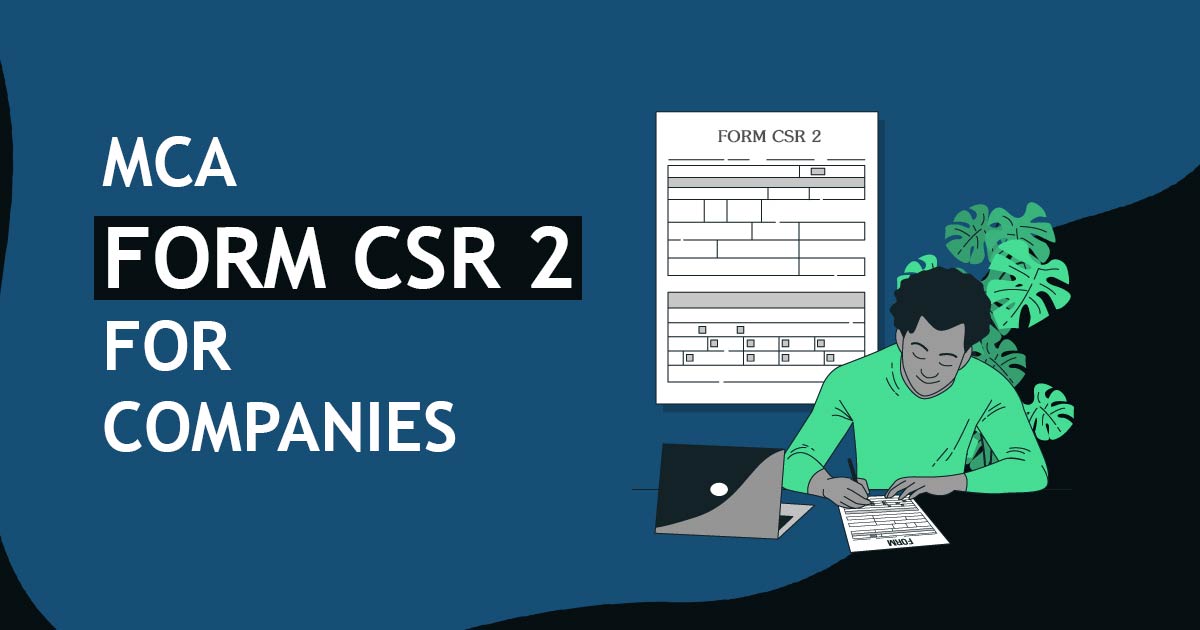View News
Comprehensive-Guide-to-Filing-CSR-2-Form

Comprehensive Guide to Filing CSR-2 Form
Introduction:
Corporate Social Responsibility (CSR) has become an integral aspect of corporate governance globally. In India, the Ministry of Corporate Affairs (MCA) mandates certain companies to undertake CSR activities and report on them annually. The CSR-2 form is an essential tool for reporting CSR activities, ensuring transparency, and fulfilling regulatory requirements. This comprehensive guide delves into every aspect of CSR-2 filing, providing detailed instructions, explanations, and insights to aid companies in complying with CSR regulations effectively.
Understanding CSR-2:
The CSR-2 form was introduced by the MCA through the Companies (Account) Amendment Rules 2022. It serves as a reporting mechanism for companies falling under Section 135(1) of the Companies Act, 2013. These companies are required to undertake CSR activities and report on them annually. CSR-2 facilitates the documentation and disclosure of CSR initiatives, expenditure, and outcomes, thereby promoting accountability and transparency in CSR practices.
Eligibility Criteria for CSR-2 Filing:
Companies falling under Section 135(1) of the Companies Act, 2013 are obligated to file CSR-2. This includes companies meeting specific financial thresholds, such as:
- Net worth of rupees five hundred crore or more,
- Turnover of rupees one thousand crore or more, or
- Net profit of rupees five crore or more during the immediately preceding financial year.
|
Tip No-1 |
|
2(a) - 2022-23 2(b) - SRN shall be of FY 2022-23 (as the form CSR-2 is being filed as addendum to AOC-4) 3(i to iii) - Net worth, turnover and net profit figures should be of the FY 2021-22, as it will determine the 3 (iv), the criteria that triggered the CSR applicability. As the figures pertaining to FY 22-23 will determine the CSR applicability and liability for FY 23-24. |
Purpose of CSR-2:
CSR-2 serves multiple purposes, including:
- Compliance: It ensures that companies meet their statutory obligations related to CSR as mandated by the Companies Act, 2013.
- Transparency: By requiring detailed reporting on CSR activities, expenditures, and outcomes, CSR-2 promotes transparency and accountability in corporate philanthropy.
- Stakeholder Engagement: CSR-2 enables companies to communicate their CSR initiatives to stakeholders, including shareholders, employees, customers, and the community, fostering trust and goodwill.
- Impact Assessment: Through the reporting of CSR activities and outcomes, CSR-2 facilitates the assessment of the social and environmental impact of corporate initiatives, helping companies evaluate the effectiveness of their CSR programs.
Reporting Requirements for CSR-2:
The reporting requirements for CSR-2 are stringent and encompass various aspects of CSR activities and expenditures. Companies are required to furnish detailed information, including:
- Audited Financial Statements of the last 3 Financial Years,
- Form AOC-4 filed for the respective financial year,
- Form MGT-7 filed for the financial year,
- Minutes of CSR Committee Meetings held during the financial year,
- Paid Challan for Form AOC-4 filed for the financial year,
- Latest Board Resolution constituting CSR Committee, and
- Company Website with Compliance menu and CSR Tab for publication verification.
Information to be Mentioned in CSR-2:
CSR-2 requires companies to provide comprehensive information related to their CSR activities, expenditures, and outcomes. This includes:
- Company Identification: CIN No. of the Company, Registered office address, and Email Id of the company.
- Financial Year Details: Start and end dates of the financial year, along with the SRN of form AOC-4/AOC-4 XBRL/AOC-4 NBFC filed by the company.
- Financial Metrics Definitions: Definitions of key financial metrics such as Net Worth, Turnover, and Net Profit as per the Companies Act, 2013.
- Criteria Triggering CSR Applicability: Details of the criteria triggering CSR applicability as per Section 135(1) of the Companies Act, 2013.
- Details of CSR Committee: Number of meetings constituted, details of directors attending the meetings, and confirmation from the latest Board Resolution and Minutes of the CSR Committee meetings.
- Company's Website Compliance: Verification of the presence of a Compliance menu and CSR Tab on the company website and publication of relevant information regarding CSR activities.
- Amount Available for Set-off: Details of the amount available for set-off in pursuance of Rule 7(3) of the Companies (CSR Policy) Rules, 2014.
- Completion of Three Financial Years: Confirmation of whether the company has completed three financial years since its incorporation.
- Net Profit and Other Financial Details: Details of profit before tax, net profit computed under section 198, and the average net profit of the company as per section 135(5).
- CSR Amount Spent and Projects Details: Confirmation of whether CSR amount has been spent, along with details of ongoing and other than ongoing projects, including project names, activities, local areas, project durations, amounts spent, and implementation modes.
- Administrative Overheads and Impact Assessment: Details of the amount spent on administrative overheads and impact assessment, if applicable.
- Total Amount Spent and Unspent: Calculation of the total amount spent for the financial year and determination of any unspent or excess amount.
- Transfer of Unspent CSR Amount: Details of the transfer of unspent CSR amount to the Unspent CSR Account as per Section 135(6) of the Companies Act, 2013.
- Transfer to Fund Specified in Schedule VII: Information on the transfer of unspent CSR amount to the fund specified in Schedule VII of the Companies Act, 2013.
- Reasons for Unspent Amount: Specification of reasons if the company has failed to spend two percent of the average net profit as per section 135(5).
- Utilization of Unspent Amount from Previous Financial Years: Confirmation of whether any unspent amount from previous financial years has been spent in the current financial year.
- Creation or Acquisition of Capital Assets: Details of any capital assets created or acquired through CSR spent in the financial year.
Procedure for CSR-2 Filing:
Gathering Documents: Companies must collect all required documents, including audited financial statements, forms AOC-4 and MGT-7, minutes of CSR committee meetings, board resolutions, paid challans, and website compliance details.
Data Compilation: Compile financial data, CSR expenditure details, project information, and other relevant information for accurate reporting.
Online Form Submission: Access the MCA portal and fill out the CSR-2 form online, providing all required information and uploading necessary documents.
Verification and Sign-off: Review the filled form for accuracy and completeness. Ensure all information is true and correct before digitally signing the form using the Director's Digital Signature Certificate (DSC).
Submission and SRN Generation: Submit the form online, after which a Service Request Number (SRN) will be generated. Note down the SRN for future reference and correspondence with the MCA.
Key Considerations for CSR-2 Filing:
Compliance with Regulatory Requirements: Ensure strict adherence to the Companies Act, 2013, and other relevant regulations while filling out the CSR-2 form.
Accuracy and Transparency: Provide accurate and transparent information regarding CSR activities, expenditures, and outcomes to uphold credibility and trust.
Timely Submission: Submit the CSR-2 form within the stipulated deadline to avoid penalties and non-compliance issues.
Document Verification: Verify all supporting documents for authenticity and accuracy before uploading them with the CSR-2 form.
Stakeholder Engagement: Communicate CSR initiatives and outcomes effectively to stakeholders through CSR-2 reporting, fostering engagement and transparency.
Continuous Improvement: Use CSR-2 reporting as an opportunity to evaluate CSR strategies, identify areas for improvement, and enhance the social and environmental impact of corporate initiatives.
Conclusion:
The CSR-2 form plays a crucial role in promoting transparency, accountability, and compliance in CSR practices among eligible companies. By providing comprehensive details of CSR activities, expenditures, and outcomes, CSR-2 facilitates effective monitoring, evaluation, and reporting of corporate philanthropy. Companies must diligently adhere to regulatory requirements, accurately report CSR initiatives, and engage stakeholders to maximize the social and environmental impact of their corporate endeavors. Through robust CSR-2 filing practices, companies can contribute positively to society while fulfilling their legal and ethical responsibilities as corporate citizens.
|
Tip No- 2 |
|
This is a STP form; if the SRN is created but the status indicate that "payment is not applicable", you will need to wait for the form to be accepted, which might take up to 48 hours. Instead of attempting to file another form, you can make a complaint on the MCA Portal. |
|
Latest Due Date Update – 2024 MCA announced that all eligible companies must file e-form CSR2 for the financial year 2022-23 on or before the due date of 31.03.2024 to avoid penal action.
|
|
Access the PDF of the CSR-2 Format by clicking the below link
|
"Unlock the Potential of Legal Expertise with LegalMantra.net - Your Trusted Legal Consultancy Partner”
Article Compiled by:-
CS Mayank Garg
(LegalMantra.net Team)
+91 9582627751
Disclaimer: Every effort has been made to avoid errors or omissions in this material in spite of this, errors may creep in. Any mistake, error or discrepancy noted may be brought to our notice which shall be taken care of in the next edition In no event the author shall be liable for any direct indirect, special or incidental damage resulting from or arising out of or in connection with the use of this information Many sources have been considered including Newspapers, Journals, Bare Acts, Case Materials , Charted Secretary, Research Papers etc.

